What Happened to Soy Yogurt? ...and How to Make Your Own
Susan Anderes. Associate, Hattner Nutrition. www.gutinsight.com
“Soy Yogurt Crisis: 2015 edition” was the headline on the web article I found while searching for some background on this topic.
For those of us who want probiotic-containing foods but who also have food allergies or for those who want to avoid animal products, this feels like a true crisis.
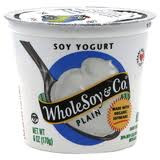
My favorite soy yogurt brand was WholeSoy until they went out of business. They produced plain and flavored soy yogurts that were tasty and the plain versions were reduced in sugar content. I have tried other brands since the demise of WholeSoy, but have yet to find any I really enjoy.
A couple of years ago, I was able to purchase plain unsweetened soy yogurt at small and large health food stores as well as fancy groceries. Then my favorite brand -- let's face it, the only brand with a palatable taste and texture -- went off line and off the shelves due to factory lease issues. Whole Soy was offline for about a year and came back slowly over the course of a year. Then all of a sudden, their products were no longer on the shelves. A perusal of their FaceBook page (their website had disappeared) yielded the explanation that they could no longer afford to service the debt on their new plant.
Other non-dairy yogurts filled in the empty shelf space previously occupied by WholeSoy. I have seen almond, coconut, rice, and hemp. I was more interested in soy for two reasons: first, soy yogurt has been scientifically studied to document the viability of its probiotic bacterial strains, and second, because the protein content of soy yogurt is the highest and closest to that of cow's milk. A couple of other food companies produced a few flavors, but I did not find them to be what I was looking for and many were excessively sweet.
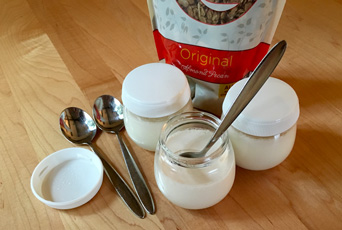
I decided to experiment with culturing plain soy yogurt at home. I canvassed the web looking for recipes and tips. There are plenty of recipes and techniques out there. I did not want to invest in yogurt making accoutrements or appliances until I knew I would like the taste. I purchased vegan yogurt starter and researched methods for making yogurt. They varied from the crock pot method, to the oven method, to the thermos method. There were many ideas on what sort of non-dairy milk to use, but many writers found that original-favored, unsweetened, higher-fat, commercial soy milks worked best and I have found the results with this type of soy milk to be very tasty.
On my first attempt I used pectin to thicken the soy yogurt because I had it on hand. There are many other thickeners that can be used. Agar agar was disappointing. Although it is not vegan, I have been happy with the results using unflavored gelatin as a thickener.
After my early attempts, I invested in a small yogurt maker and some additional jars. Although you do not need a yogurt maker, I find it more convenient. I use Bella Bella non-dairy yogurt starter. My recipe follows.
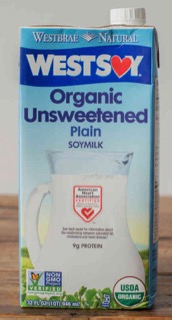 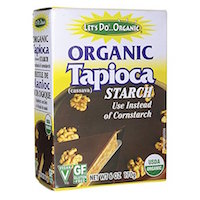 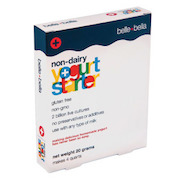
Soy Yogurt
Ingredients
1 qt unsweetened plain soy milk (fat content 5g per 8 oz.)
1 portion thickener of choice (2 tablespoons tapioca starch)
1 sachet of non-dairy yogurt starter
Method
In a saucepan, simmer the soy milk until it reaches a temperature of 180°F.
Further cool the soy milk to 110-112°F. To speed this process, set the soy milk saucepan into another bowl with cold water in the bottom. You might need to change the water as your cool the liquid.
When the soy milk has cooled to 140°F, mix 1 cup of the soy milk in a bowl with the tapioca starch and stir to remove lumps. Pour that mixture back into the rest of the warm soy milk.
Further cool the soy milk to 110-112°F. Mix 1 cup of the warm soy milk and the yogurt starter in a small bowl and stir to remove lumps. Pour that mixture into the rest of the 110°F soy milk. Stir or whisk thoroughly.
Pour the soy milk mixture into yogurt containers in the yogurt maker using a funnel. Culture the yogurt for at least 12 hours — usually overnight in the yogurt maker. Culturiing for up to 24 hours also works and results in a more tangy taste. Refrigerate until cool. Eat and enjoy!
Notes
I make only plain soy yogurt. When it is finished, I might add granola to eat it for breakfast or a bit of maple syrup when eating a snack. You could add fresh fruit or a bit of jam to flavor it after it is cultured.
I use a Polder Digital Thermometer/Timer to track the temperature and a funnel to transfer from pot to yogurt jars.
|
 Print or save PDF recipe Print or save PDF recipe
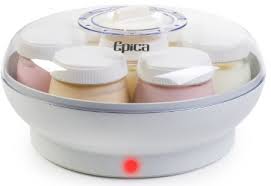
Other helpful websites for techniques and thickeners:
• Easy Homemade Vegan Yogurt: No Equipment Required Link
• How to Make Your Own Yogurt Link.
For more information on the soy yogurt crisis, see:
Ed v. Food: Vegan food for the culinarily inept
Soy Yogurt Crisis: 2015 edition Link
WholeSoy & Co. - Facebook Link
“It is with very heavy hearts that we announce WholeSoy & Co. will be closing…”
References
Farnworth ER, Mainville I, Desjardins MP, Gardner N, Fliss I, Champagne C. Growth of probiotic bacteria and bifidobacteria in a soy yogurt formulation. Int J Food Microbiol. 2007;116(1):174-81. PubMed PMID: 17292991.
Wagar LE, Champagne CP, Buckley ND, Raymond Y, Green-Johnson JM. Immunomodulatory properties of fermented soy and dairy milks prepared with lactic acid bacteria. J Food Sci. 2009;74(8):M423-30. PubMed PMID: 19799669
|